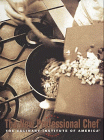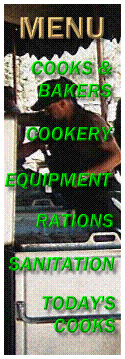
David Castle's Army Kitchen Truck
Serving Meals in the Combat Area
Excerpted from the 1951 edition of Mess Management (TM 10-402)
[Regimental trains] [Three
meals daily] [Two trips daily]
[Temporary kitchen shack] [Carrying
food forward]
Feeding troops in combat situations has always been tough. Since commanders recognize that good morale comes with serving hot chow to troops in the combat zone, aggressive commanders instructed their cooks to bring one or two hot meals forward each day, often under the cover of darkness. These commanders knew what happened to morale when their troops subsisted on C-rations for weeks on end.
Lt. Col. Coy W. Baldwin wrote in the May-June 1953 of the Quartermaster Review: "Still more surprising is that old campaigners learn to realize the truth of a saying that has become axiomatic in Korea -- 'the farther forward, the better the food.'" By the time Korea and Vietnam rolled around, the Army and the Marines had perfected the art of feeding hot meals to combat troops.
When the tactical situation will not permit unit messing at a semi-permanent installation, a site is selected for the company messing in the forward area. This company location should be near the troops, concealed from hostile observation, and protected from trajectory fire. The time of serving hot meals conforms as nearly as possible to the usual meal hours.
There are several methods to use in getting the food to the messing area, depending primarily on the tactical situation:
Locating kitchen truck with the regimental train
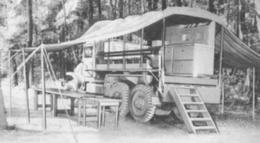
Vehicles are grouped and under the control of the regimental supply officer, are conducted to the regimental point of release, where they are released to subordinate control. The point of release should be located on the route to the forward area and at a point convenient to the battalions. The vehicles the are escorted under battalion control to the battalion release points, where they are turned over to company representatives, who guide them to the company mess locations. Men who can come to the company mess location are fed there; others are served by carrying parties, who take the food to them in insulated containers.
Serving three meals each day to the company
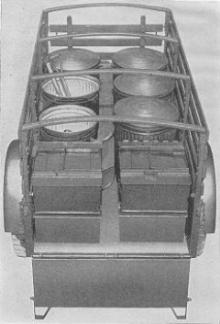
Vehicles make two trips each day to the company area
When it is not possible to prepare meals in the forward area and the traffic conditions are not bad, an alternative procedure may be used. At dusk, motor vehicles will carry supper up to the mess location. While this is being done, the company mess details at the bivouac will begin to prepare the hot breakfast and the cold lunch. The vehicles will make a return trip to the forward area with these two meals. This procedure involves two trips forward during the night.
Temporary kitchen shack in the company area
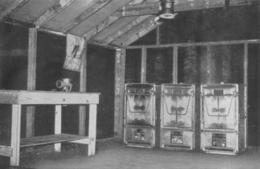
Carrying hot meals to troops in forward fighting positions
Some situations may require the use of insulated food containers to take the food to more forward areas for small groups when messing in a company area would not be possible. The company commander would arrange to have men at the mess location when the vehicle arrived with insulated containers.
David Castle's Restored Army Kitchen Truck
Bibliography
Dept. of the Army. Mess Management. TM 10-402. Washington: GPO, March 21, 1951. 80pp. This information is taken from page 57.
February 2000
| Bulletin Board | Keyword Search |
| Bookstore | Links |
| About Us | Recent Additions |

